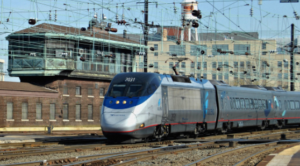High-Speed Rail Is The Future—But It Should Already be the Present

 by Solaiman Hassanin ‘23
by Solaiman Hassanin ‘23
“High-speed rail is an important part of our vision for a safe, flexible, seamless intermodal transportation system—providing for economic growth and greater mobility for both rural and urban Americans—in the 21st century.” Those were the words of the U.S. Transportation Secretary Rodney Slater in 1998. Twenty-three years after his press release, China has built 37,900 kilometers of high-speed rail as of 2021, France has built 3,220 kilometers, Spain 3,100 kilometers, Japan 3,041 kilometers, Germany 3,038 kilometers as of 2018, and then finally the United States—735 kilometers.
It may as well be 0 kilometers. The United States only has one rail line that reaches the mark of “high-speed rail”: Acela, a rail line that only hits 150 kilometers per hour occasionally, with an average speed of 66 kilometers. Yes, even America’s only high-speed rail line only hits the mark of “high-speed” for a limited time. Objectively, the United States has continued to fall behind on transportation, with the first operational full high-speed rail line not expected to open in California until 2030. For reference, China opened its first high-speed rail line in 2008, and in the same timeframe it has taken America to build one line, China has built one of the best railway systems in the world from the bottom up.
There is no excuse for the ineffectiveness of America at building new modes of modern transport, as high-speed rail offers an environmentally friendly alternative to airplane travel and a cheap and effective mode of transportation. According to a report by the International Energy Association, rail, despite making up eight percent of the world’s transportation, causes just two percent of the world’s transportation energy consumption. The report also stated that if all services currently performed by airplanes and trucks were done by rail the world would reduce greenhouse gas emissions by 1.2 billion tonnes.
It is not just an impossible dream. Not only has China built extensive rail, but the United States, too, has a history of great transportation achievements. Throughout the 50s and 60s, America built up its interstate highways, eventually creating the most extensive highway system in the world. To this day America’s highways remain an integral part of its vast nation, accounting for the majority of transport and interstate trade. While highways have served and will continue to serve America well, it is time to move past the 20th Century and recognize the importance of public transportation. It is time to do what we did in the 50s again, and once again reinvent our means of transportation to fit this time and this age.